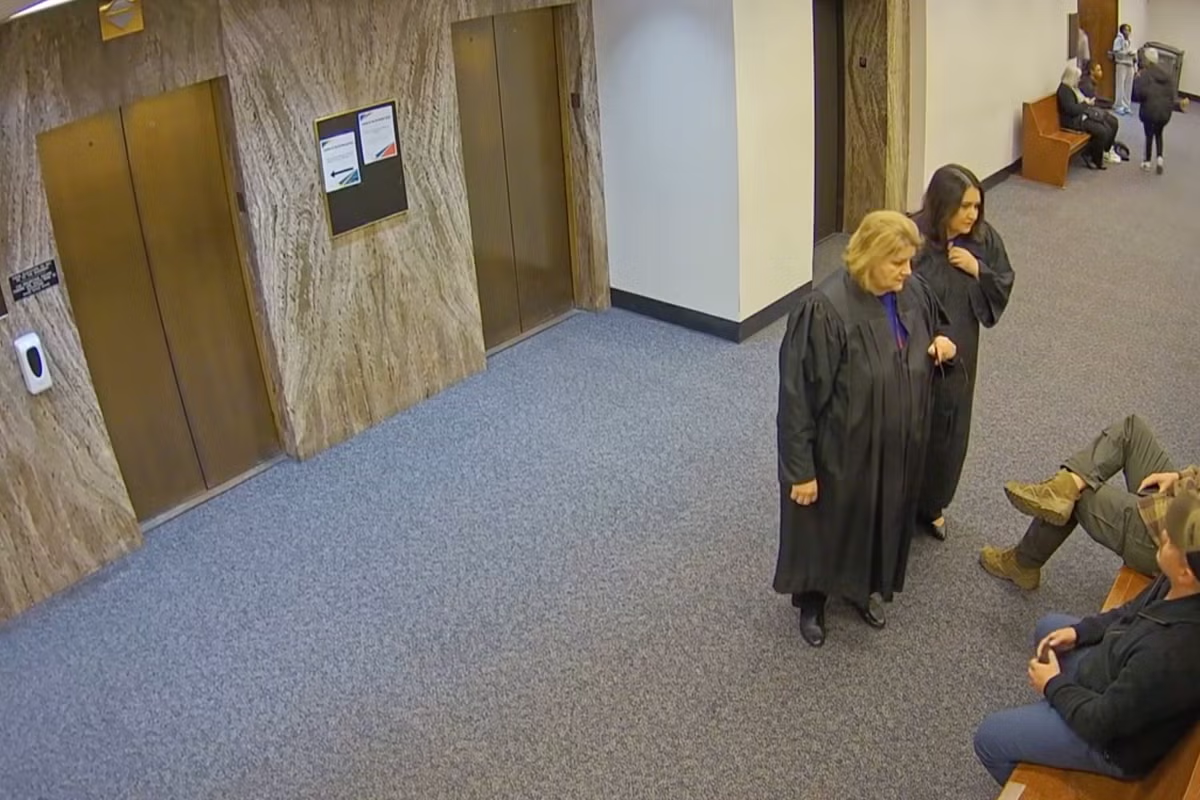The relationship between judicial authority and federal law enforcement has long been an area where legal interpretation, institutional boundaries, and constitutional responsibilities intersect. Courts operate as independent branches of government, entrusted with fair adjudication and public confidence. Federal agencies, including immigration authorities, are responsible for enforcing congressional statutes and administrative mandates. When these institutions collide, especially inside a courthouse, questions about the limits of judicial power and the scope of federal authority immediately surface.
In the United States, occasional disputes between courts and federal enforcement agencies are not unprecedented, but instances leading to criminal charges against a sitting judge are exceedingly rare. These moments do more than draw public attention—they prompt deeper examination of how judicial discretion is exercised, how authority is checked, and what standards guide conduct when public institutions disagree.
The legal case involving Milwaukee County Circuit Court Judge Hannah Dugan has become one such moment of national scrutiny. It centers on allegations connected to a courtroom interaction, federal immigration enforcement, and the handling of a defendant facing both state charges and immigration detention. The case has raised questions about the boundary between judicial procedures and federal arrest authority, the meaning of “official acts,” and the legal protections judges do or do not have when accused of misconduct.
This article examines the key facts, allegations, legal arguments, and ongoing implications of the federal case, relying only on verified public information and clearly distinguishing the established record from claims still contested in court.
Background: A Judge, a Defendant, and a Disputed Interaction
Hannah Dugan has served as a Milwaukee County Circuit Court judge, presiding over criminal cases and maintaining responsibilities consistent with Wisconsin’s judicial standards. On April 18, a courtroom incident involving immigration enforcement triggered a series of legal actions that ultimately resulted in her arrest by federal agents and a formal indictment.
The events began when Eduardo Flores-Ruiz, a 31-year-old Mexican national, appeared in her courtroom for matters related to state misdemeanor domestic abuse or battery charges. According to federal authorities, U.S. Immigration and Customs Enforcement (ICE) had issued an administrative warrant for his arrest. Agents waited at the courthouse to detain him following the hearing. Flores-Ruiz had previously been removed from the United States in 2013, a fact later acknowledged in public reporting.
The critical dispute centers on what happened next—specifically, whether Judge Dugan unlawfully interfered with the attempted arrest, or whether she acted within the range of judicial discretion in managing courtroom processes and safety.
The Federal Allegations
A federal criminal complaint outlines two primary allegations:
-
Obstruction of a proceeding
-
Concealing a person to prevent arrest
According to prosecutors, after speaking with ICE officers, Judge Dugan directed them to seek a judicial warrant rather than rely on the administrative warrant they possessed. The complaint states that she told agents they needed a different form of authorization to enter the courtroom and take the defendant into custody.
The complaint further alleges that she directed ICE agents away from the courtroom’s primary exit and allowed Flores-Ruiz and his attorney to leave through a “jury door” or side exit leading into a nonpublic hallway not open to the public.
Federal prosecutors characterize this action as an intentional effort to prevent the defendant’s arrest. They contend that the judge’s instructions delayed ICE’s attempt to detain Flores-Ruiz and created an opportunity for him to move into an area of the courthouse where agents could not immediately locate him.
Despite leaving through the side exit, Flores-Ruiz was subsequently arrested outside the courthouse later the same day.
The Judge’s Position and Bodycam Footage
Dugan has pleaded not guilty to both federal charges. Through counsel, she denies committing any criminal offense and asserts that her actions were consistent with standard judicial procedures.
Body-camera footage described in media reports, recorded after the incident, shows Judge Dugan addressing officers’ concerns. In the footage:
-
She denies hiding the defendant in chambers or a jury room.
-
She acknowledges allowing him to exit through a back door, but defends the practice as something used “when circumstances warrant.”
-
She states that she did not know the defendant was undocumented.
Her defense teams maintain that courthouse exits vary in use depending on safety considerations, case sensitivities, and situational needs within a courtroom.
Judicial Immunity Claim and Court Rejection
A major early dispute centered on whether Judge Dugan’s actions qualified as “official acts” entitling her to judicial immunity. Judicial immunity protects judges from criminal or civil liability for decisions made as part of their official duties.
Dugan’s attorneys argued that managing people within a courtroom—directing attorneys, defendants, and law enforcement personnel—falls squarely within her judicial responsibilities. They contended that because she was performing her official role, she could not legally be prosecuted.
A federal judge rejected this argument. In a written order, the court ruled that the conduct alleged in the indictment could be interpreted as exceeding the judge’s lawful authority and therefore did not qualify for immunity at this stage. The judge noted that whether an act is considered judicial depends on its nature, not merely on the setting in which it occurred. The ruling emphasized that actions allegedly aimed at concealing a person from arrest could fall outside the boundaries of judicial power.
Suspension from Judicial Duties
The Wisconsin Supreme Court subsequently suspended Dugan from her judicial duties while the federal case proceeds. This suspension reflects standard administrative practice when serious felony charges are brought against a sitting judge. It prevents her from presiding over cases or performing judicial functions until her legal situation is resolved.
The Defendant’s Case and Federal Context
Eduardo Flores-Ruiz, the individual at the center of the disputed incident, faced misdemeanor domestic abuse or battery charges in Wisconsin state court at the time. Publicly available records confirm that he had been previously removed from the United States in 2013. Reports also confirm that after leaving the courtroom via the side exit, he was later arrested by ICE agents outside the courthouse.
While commentary circulating online has described him with broader claims about violent histories or additional criminal charges, only the verified misdemeanor case and his prior removal have been substantiated in official documents or reputable reporting. It remains important to distinguish between allegations, political characterizations, and confirmed records.
What Remains Unproven
Several key points remain unresolved:
-
Judge Dugan’s intent: Prosecutors will need to prove that she knowingly and deliberately attempted to obstruct a federal arrest.
-
Full circumstances and rationale: Her defense will argue that she acted properly within courtroom management duties.
-
The accuracy of government interpretation: Whether her instructions genuinely interfered with federal authority is a matter for trial.
-
Outcome and sentencing risks: While she faces up to six years in prison, this is only a statutory maximum; she has not been convicted.
The judge has firmly denied criminal wrongdoing.
The Case Moves to Trial
A federal scheduling order sets:
-
Jury selection beginning December 11
-
Trial commencement projected for December 15
Given the nature of the charges, testimony will likely include ICE officers, courthouse staff, possibly courtroom video, bodycam footage, and expert analysis of judicial authority. Legal scholars and observers note that the case may become an important test of the boundaries of judicial immunity and the responsibilities judges hold when interacting with federal enforcement agencies inside state courthouses.
Wider Implications for the Justice System
This case raises broader questions about:
-
How judges balance courtroom control with federal enforcement presence
-
What rules govern interactions with administrative immigration warrants inside court facilities
-
How to maintain neutrality and safety without appearing to obstruct enforcement
Courthouses often host multiple agencies with competing priorities. Judges must ensure due process and courtroom order. Federal agents must execute lawful arrest mandates. When these tasks intersect without clear protocols, misunderstandings can escalate into legal conflicts.
The trial will likely influence future guidance on these interactions, particularly in jurisdictions where immigration enforcement routinely seeks defendants after court proceedings.
Conclusion
The federal case against Judge Hannah Dugan is one of the rare instances in which a sitting judge faces criminal charges related to her conduct on the bench. The allegations are serious, but they remain unproven, and she has pleaded not guilty. The legal process will determine whether her actions constituted obstruction or whether they were within the scope of judicial discretion.
Whatever the verdict, the case underscores the delicate balance between state judicial authority and federal enforcement power. It serves as a reminder of the complex, sometimes tense relationship between institutions charged with upholding the law, each operating under different mandates, legal standards, and expectations.
The trial in December will provide the full evidentiary record needed to assess the facts and determine responsibility. Until then, the case remains a significant moment at the intersection of judicial practice, immigration enforcement, and federal criminal law—one that will likely influence courtroom procedures and institutional boundaries for years to come.

James Jenkins is a celebrated Pulitzer Prize-winning author whose work has reshaped the way readers think about social justice and human rights in America. Raised in Atlanta, Georgia, James grew up in a community that instilled in him both resilience and a strong sense of responsibility toward others. After studying political science and creative writing at Howard University, he worked as a journalist covering civil rights issues before dedicating himself fully to fiction. His novels are known for their sharp, empathetic portraits of marginalized communities and for weaving personal stories with broader political realities. Jenkins’s breakout novel, Shadows of Freedom, won national acclaim for its unflinching look at systemic inequality, while his more recent works explore themes of identity, resilience, and the fight for dignity in the face of oppression. Beyond his novels, James is an active public speaker, lecturing at universities and participating in nonprofit initiatives that support literacy and community empowerment. He believes that storytelling is a way to preserve history and inspire change. When not writing, James enjoys jazz music, mentoring young writers, and traveling with his family to explore cultures and stories around the world.









